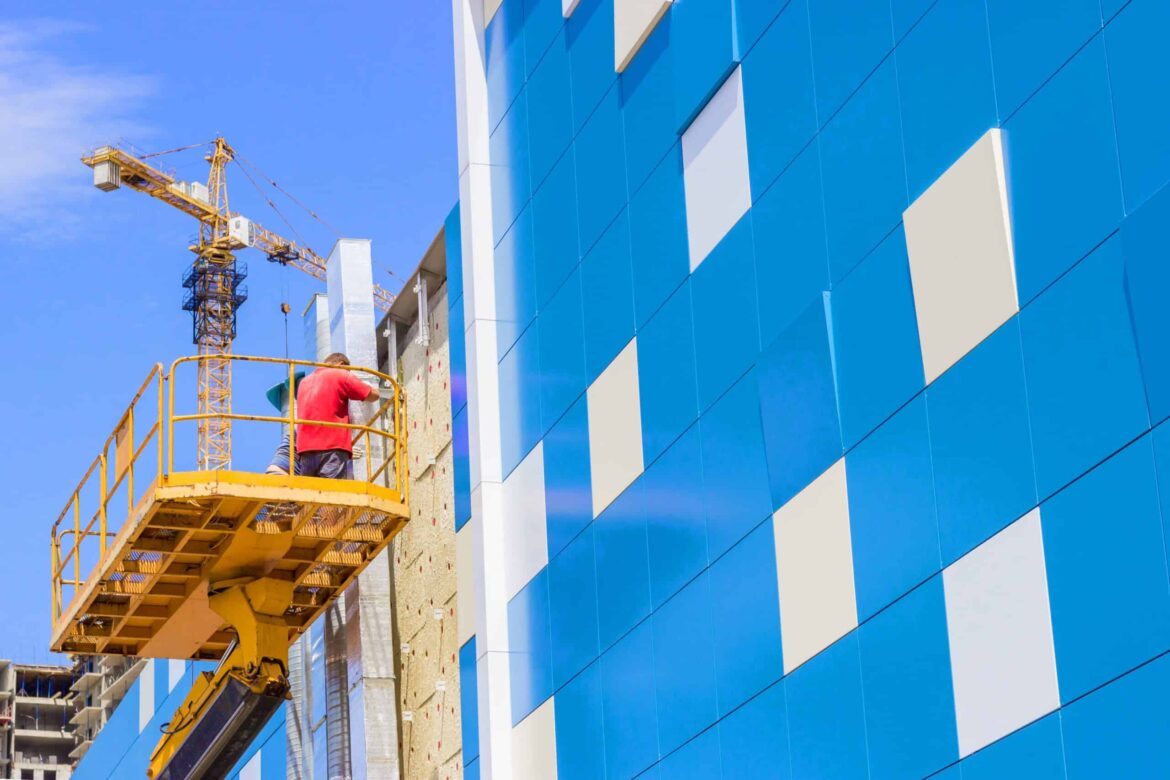Cladding is a term that is often used in the construction and architecture industry, but what does it actually mean? In simple terms, cladding refers to the external layer or covering of a building. It serves as a protective and decorative layer, providing insulation and enhancing the aesthetic appeal of a structure. Cladding can be made from a variety of materials and comes in different styles and designs, making it a versatile option for any building project.
In this blog post, we will delve deeper into the world of cladding, exploring its various types, benefits, materials, installation process, maintenance, regulations, safety measures, and future trends. Whether you are a homeowner, architect, or builder, this guide will provide you with all the essential information you need to know about cladding.
What is Cladding?
As mentioned earlier, cladding is the external layer or covering of a building. It is essentially a skin that protects the underlying structure from external elements such as weather, wind, and moisture. Cladding also plays a crucial role in enhancing the appearance of a building, giving it a unique and attractive look.
Cladding is not a new concept; it has been used in construction for centuries. However, with advancements in technology and design, cladding has evolved into a more sophisticated and efficient building material. Today, it is widely used in both residential and commercial buildings, providing numerous benefits to the structure and its occupants.
Types of Cladding
There are several types of cladding available in the market, each with its own set of characteristics and advantages. Let’s take a closer look at some of the most popular types of cladding:
Timber Cladding
Timber cladding is one of the oldest forms of cladding and is still widely used today. It involves using wooden boards or planks to cover the exterior of a building. Timber cladding is popular due to its natural and rustic appearance, making it a great choice for traditional and contemporary designs.
One of the main benefits of timber cladding is its sustainability. Wood is a renewable resource, making it an environmentally friendly option for cladding. It also offers good insulation properties, helping to regulate temperature and reduce energy costs. However, timber cladding requires regular maintenance to prevent rotting and warping.
Stone Cladding
Stone cladding involves using thin layers of natural or artificial stone to cover the exterior of a building. It is a popular choice for high-end projects as it gives a luxurious and elegant look to the structure. Stone cladding is available in a variety of colors, textures, and patterns, providing endless design possibilities.
One of the main advantages of stone cladding is its durability. It can withstand harsh weather conditions and is resistant to fire and pests. However, stone cladding can be expensive and requires skilled labor for installation.
Metal Cladding
Metal cladding involves using metal sheets or panels to cover the exterior of a building. It is a popular choice for modern and industrial-style buildings. Metal cladding is available in various materials such as aluminum, steel, copper, and zinc, each with its own unique characteristics and appearance.
One of the main benefits of metal cladding is its low maintenance. It is resistant to corrosion and does not require regular painting or sealing. Metal cladding is also lightweight, making it easier and faster to install. However, it can be noisy during heavy rain or hailstorms and may not be suitable for all climates.
Benefits of Cladding

Cladding offers numerous benefits to both the building and its occupants. Let’s take a look at some of the key advantages of using cladding in construction:
Protection from External Elements
One of the primary functions of cladding is to protect the building from external elements such as rain, wind, and UV rays. It acts as a barrier, preventing moisture from seeping into the structure and causing damage. Cladding also helps to regulate temperature, keeping the interior of the building cool in summer and warm in winter.
Enhanced Aesthetic Appeal
Cladding can significantly enhance the appearance of a building, giving it a unique and attractive look. With a variety of materials, styles, and designs available, cladding offers endless possibilities for creating a visually appealing exterior. It can also be used to blend in with the surrounding environment or make a statement with a bold and modern design.
Improved Insulation
Cladding can provide additional insulation to a building, helping to reduce energy costs. Materials such as timber and stone have natural insulating properties, while metal cladding can be combined with insulation materials to improve thermal efficiency. This not only benefits the occupants but also contributes to a more sustainable and eco-friendly building.
Low Maintenance
Most types of cladding require minimal maintenance, making it a cost-effective option in the long run. Unlike traditional paints and coatings, cladding does not need to be repainted or sealed regularly. This saves both time and money, making it an attractive choice for many building projects.
Cladding Materials
As mentioned earlier, cladding can be made from a variety of materials, each with its own unique characteristics and advantages. Let’s take a closer look at some of the most commonly used cladding materials:
Wood
Wood is a popular choice for cladding due to its natural and warm appearance. It is also a renewable resource, making it an environmentally friendly option. However, wood requires regular maintenance to prevent rotting and warping.
Stone
Stone cladding is available in natural or artificial form and offers a luxurious and elegant look to a building. It is durable and resistant to fire and pests, but can be expensive and requires skilled labor for installation.
Metal
Metal cladding is lightweight, low maintenance, and offers a modern and industrial look to a building. It is available in various materials such as aluminum, steel, copper, and zinc, each with its own unique characteristics and appearance.
Brick
Brick cladding involves using thin layers of bricks to cover the exterior of a building. It is a popular choice for traditional and rustic designs and offers good insulation properties. However, brick cladding can be heavy and may require additional structural support.
Cladding Installation
The installation process for cladding varies depending on the type of material used. However, there are some general steps that need to be followed for a successful cladding installation:
- Prepare the surface: The surface where the cladding will be installed needs to be clean, dry, and free from any debris or loose materials.
- Measure and cut the cladding: Accurate measurements need to be taken to ensure the cladding fits perfectly. The cladding material should then be cut to the required size and shape.
- Install the framework: A framework needs to be installed to support the cladding. This can be made from wood, metal, or other suitable materials.
- Attach the cladding: The cladding is then attached to the framework using screws, nails, or adhesives, depending on the type of material used.
- Seal the edges: The edges of the cladding need to be sealed to prevent moisture from seeping in.
- Finish the installation: Any finishing touches, such as painting or sealing, can be done once the cladding is fully installed.
It is important to hire a professional and experienced contractor for cladding installation to ensure it is done correctly and efficiently.
Cladding Maintenance

While cladding requires minimal maintenance, it is still important to take care of it to ensure its longevity and effectiveness. Here are some tips for maintaining your cladding:
- Regularly clean the cladding using a mild detergent and water to remove any dirt or debris.
- Inspect the cladding for any signs of damage, such as cracks or gaps, and repair them immediately.
- If you have timber cladding, make sure to regularly check for rotting or warping and treat it accordingly.
- Avoid using harsh chemicals or abrasive materials on the cladding as it can damage the surface.
- If you notice any issues with the cladding, consult a professional for advice and repairs.
Cladding Regulations
In recent years, there has been an increased focus on the safety and regulations surrounding cladding due to several high-profile incidents involving cladding fires. As a result, many countries have implemented stricter regulations and guidelines for cladding installation to ensure the safety of buildings and their occupants.
For example, in the UK, all new buildings over 18 meters in height must undergo a fire safety assessment before cladding can be installed. In Australia, the use of certain types of cladding, such as aluminum composite panels, has been banned due to fire safety concerns. It is essential to research and comply with local regulations when considering cladding for a building project.
Cladding Safety
As mentioned earlier, cladding safety has become a major concern in recent years. While cladding offers numerous benefits, it is crucial to ensure that it is installed and maintained correctly to prevent any potential hazards. Here are some safety measures to keep in mind when using cladding:
- Use fire-resistant materials: When choosing cladding materials, opt for those that are fire-resistant to reduce the risk of fire spreading.
- Follow regulations and guidelines: Make sure to follow all local regulations and guidelines for cladding installation to ensure the safety of the building and its occupants.
- Regularly inspect and maintain the cladding: As mentioned earlier, regular maintenance and inspections are essential to identify any potential hazards and address them promptly.
- Hire a professional contractor: It is crucial to hire a reputable and experienced contractor for cladding installation to ensure it is done correctly and safely.
Cladding Trends
Cladding has come a long way from being just a functional building material. Today, it is also used as a design element, with architects and designers experimenting with different materials, colors, and patterns to create unique and eye-catching exteriors. Some of the current trends in cladding include:
- Sustainable materials: With a growing focus on sustainability, there has been an increase in the use of eco-friendly and renewable materials for cladding, such as bamboo and recycled wood.
- Textured finishes: Textured finishes, such as stone or brick effect, are becoming increasingly popular for adding depth and character to a building’s exterior.
- Bold colors: While neutral colors have been the go-to choice for cladding, there has been a rise in the use of bold and vibrant colors to make a statement and add personality to a building.
- Mixed materials: Combining different materials, such as metal and wood, is a trend that is gaining popularity for creating a unique and modern look.
Future of Cladding
The future of cladding looks promising, with advancements in technology and design leading to more efficient and sustainable options. Some of the developments we can expect to see in the future include:
- Smart cladding: With the rise of smart buildings, there is a growing demand for cladding that can integrate technology, such as sensors and solar panels, to improve energy efficiency and functionality.
- Biodegradable materials: As sustainability becomes a top priority, we can expect to see more biodegradable and environmentally friendly materials being used for cladding.
- 3D printing: The use of 3D printing technology in construction is on the rise, and we can expect to see it being used for creating unique and intricate cladding designs in the future.
Conclusion
Cladding is an essential building material that offers both functional and aesthetic benefits. With a variety of materials, styles, and designs available, it is a versatile option for any building project. However, it is crucial to ensure that cladding is installed and maintained correctly to prevent any potential hazards. By understanding the different types of cladding, its benefits, materials, installation process, maintenance, regulations, safety measures, and future trends, you can make an informed decision when considering cladding for your next building project. Back Continue WriteNext
Read more blogs : Paradise Valley Mall Embarks on Radical Transformation: Discover the Future of Shopping




